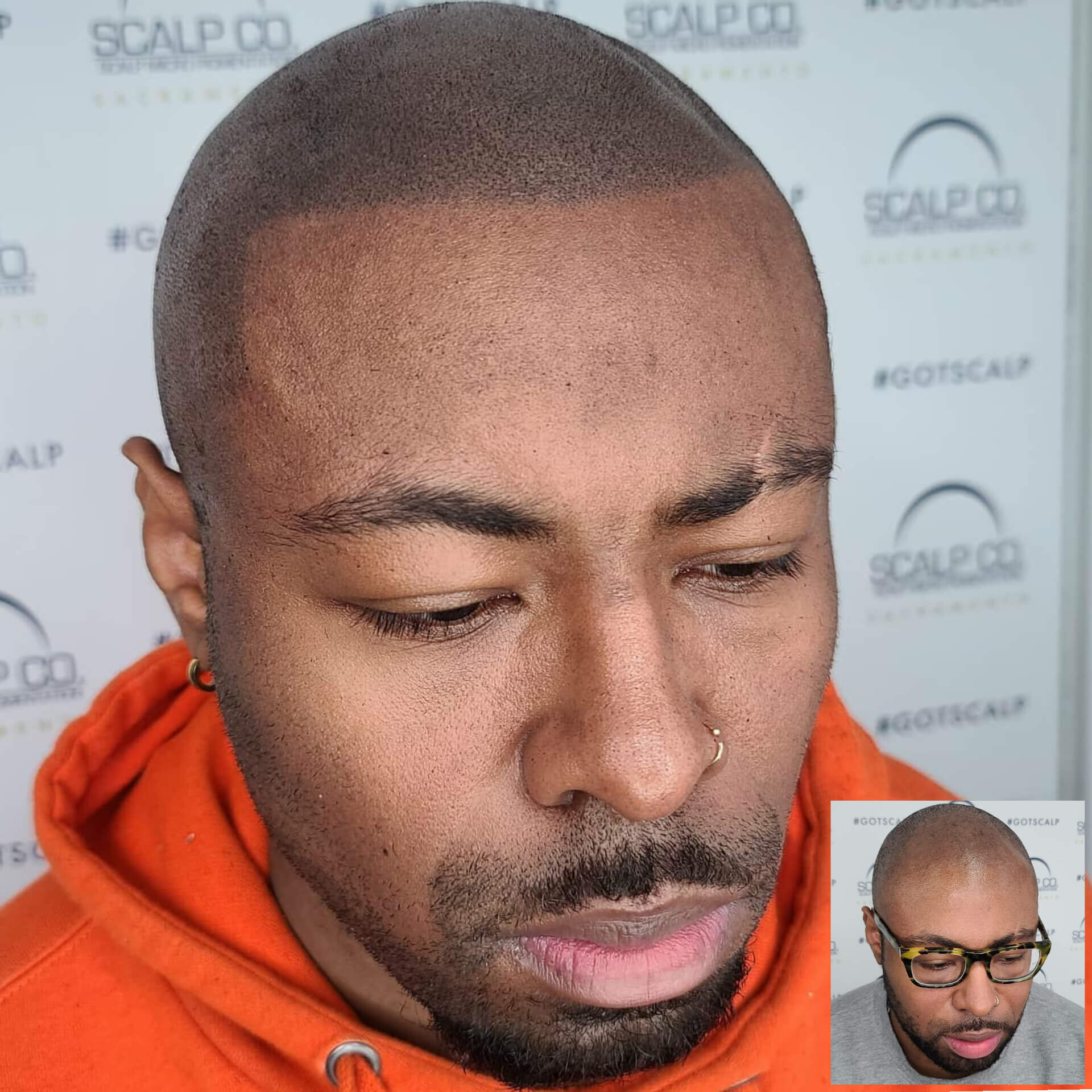Who Benefits from Micropigmentation?
When men reach a certain age, they start to look around their family tree to see who still has their hair and who's lost the good fight.
If it looks like the odds are stacked against them, they typically accept their fate by shaving their head or asking their barber to clip their remaining hair down to a one.
Truth is, if balding is in their future, they're part of the "in-crowd." The American Hair Loss Association says that, by the age of 50, about 85% of men will have experienced hair loss.
Since the inception of micropigmentation, however, all these men are needlessly suffering. Hair density can be re-established within a few treatment sessions. And this isn't just for men who don't want to go around wearing a hat all the time.
Women, too, can benefit from micropigmentation to restore their former look of fuller hair. Let's talk about this new process taking over the world and see if we can flip your wig.
What Is Micropigmentation?
People tend to relate micropigmentation to two things: microblading and tattooing. Microblading is, in a way, similar. It creates a fuller effect for fading eyebrows. Tattooing is related because both micropigmentation and tattooing use a similar electric device.
So, what exactly is micropigmentation, then? First, it's targeted at the scalp. It tackles areas within the hairline that are thinning. Micropigmentation creates shadows and depth through a series of layered dots in different hues of black.
These layered dots are no larger than the size of your natural hair follicle. This allows them to blend in seamlessly with your existing hair.
Micropigmentation differs from microblading in that microblading typically uses a single blade while micropigmentation uses an electric tattoo device. But, each creates very natural-looking effects that diminish the obvious signs of hair loss.
Who Benefits from Micropigmentation?
Men with receding hairlines are the most common candidates. Micropigmentation can actually lower their receding hairlines and restore their former look.
And, if their hairlines aren't receding, but that pesky little bald spot is starting to form on the crowns of their heads, then micropigmentation can help there, too.
Women
Wherever hair is thinning, this process can create an underlying shadow and establish a fuller effect. So, women, too, are seeking out micropigmentation if they've enjoyed a lifetime of full hair, only to notice it falling out more and more in the shower.
Men with receding hairlines reap the benefits of scalp micropigmentation because shaven hair follicles are replicated. But, anyone with thinning hair - men and women alike - will be able to diminish the stark contrast between the scalp and the remaining hairline.
Again, that underlying layer of deep color will do wonders for thinning hair. But, this isn't all about cosmetics.
Alopecia, Cancer, and Scarring
People suffering from alopecia (where intermittent patches throughout their heads are bald) can also find relief with micropigmentation.
People suffering from the ravages of cancer can benefit from micropigmentation as they deal with the various stages of baldness. Take a look at our portfolio to see how both men and women have enjoyed the benefits of this service.
You'll notice we've also worked with people who've dealt with the after-effects of scarring on their scalp. Micropigmentation can fill in that scar line with small dots along the scar line to help it blend better.
Three Types
When pursuing scalp micropigmentation for yourself, know that you can hone in on one of three different types. This isn't just for someone trying to get ahead of their receding hairline, although they're certainly prime candidates. Here are your options:
1. Receding Hairlines
This option will lower your hairline back down to where it used to be. Your certified artist will use hairline ink to create a realistic effect. The end result will be a clean, naturally-blended hairline.
2. Density
What if you've maintained your hairline, but you notice a lot of thinning going on up top? Then, you'll definitely want to look into treatments aimed at density. This is great for both men and women.
Along with the healthy hair that still remains, pigment will be added to the hairless spots along the scalp. This creates a three-dimensional look that will give the illusion of fuller hair.
3. Edge Up
The edge up another popular option. This deals with the delicate portions of the hairline, including the temple.
This is for precise hands only, given the sensitive parts it deals with, but the end result is a cleaned up hairline that'll take you back a few years in time.
But, Is It Like a Tattoo?
Let's go back to the common question about micropigmentation's relation to tattooing. The reason it isn't like a tattoo is because scalp micropigmentation doesn't penetrate the skin in the same way a tattoo does. It's a form of cosmetic tattooing and, typically, these are only done on the surface layer of the skin.
Meanwhile, traditional tattoos penetrate the surface layer of the skin and deposit ink to the deeper layer of the skin (the dermis) which contains those pesky nerves and blood vessels that make the procedure less than comfortable.
Does It Hurt?
If we're being honest here, the answer is "a little." But, it's more of a discomfort than a pain. Numbing agents are applied to the scalp before the process begins. But, if you tend to have a sensitive scalp, then there may be a tiny bit of discomfort.
That's just the honest truth. Is it a level ten kind of pain? No, not at all. But, there may be a certain level of discomfort. Once you find a skilled artist, discuss this with them.
Since they're skilled, they'll have watched hundreds of people with varying thresholds for pain undergo the procedure and can tell you exactly what to expect.
If you have any pre-existing conditions like acne on your scalp or psoriasis, then your technician will probably advise you to wait until you're in a period without a flareup. But, as for scalp that's unafflicted, the numbing agent will go a long way toward thwarting those feelings of discomfort.
What's the Timeline?
Since we're dealing with a series <em>very </em>small dots across varying surface areas on the scalp, each session averages about four or five hours.
This includes the time required to apply the numbing agent and discuss any last-minute thoughts or concerns. Together, you and your artist will decide the exact pigment color and other details that will impact the final outcome.
Typically, people need more than one session because the dots are layered in varying tones. This creates the shadowed effect that establishes a really natural look to the hairline.
We've had clients come in to address small areas, like a widow's peak, but they still needed more than one treatment to get each of those layers established.
What to Expect After Each Procedure
Each treatment needs to be scheduled a few weeks apart. You won't be in pain for this length of time. You should only experience a little redness for a day or two after the procedure.
But, in the weeks in between, your artist will tell you not to swim, use saunas or steam rooms, or take super hot showers.
You'll also want to avoid exposure to the sun as much as possible (and especially in the first four or five days after treatment).
It's important to note here that you'll want to shower prior to each procedure. (Women, let your hair fully dry before you make your way to the office.)
You can't get your scalp wet for four days after each session. This includes shower water and sweat. After that four day mark, you'll also be asked to start moisturizing the area.
How Long Does It Last?
Most cosmetic tattooing is semipermanent. As such, it should last for several years. It's not surprising to see people go eight years before they need another touchup. Remember, it's not penetrating all the way down to the dermis like tattooing, so it will fade over time.
But, the color should only lighten, not change. And, if you tend to have very dry scalp, the pigment may lighten a little more rapidly for you because skin flakes as it dries, taking a little bit of that pigment with it as it goes.
Still, the skin naturally exfoliates itself, whether you have oily or dry scalp. Over the course of many years, it will take bits of color away from each dot. But, this is where the edge up comes in. Color and density can be restored in a shorter amount of time than the initial procedure.
Are There Any Risks?
You'll find that the risks here are similar to those that come with a tattoo. Possible allergic reactions to the ink may occur, as well as an infection.
Of course, allergic reactions can't necessarily be predicted, but infections can be avoided. This is where your due diligence will serve you well.
How to Pick the Best Center
First, you have to make sure your artist is certified. Make sure the treatment center you've honed in on posts each artist's certification. You also want to see each artist's bloodborne pathogen certification. The last cert you want to see posted is the center's county health permit.
Take a look around during your consultation. Does every surface seem clean? How does the sink area look?
You also want to know that each client receives his or her own set of packaged needles. You want these to be opened in front of you. And, of course, the artist must wear barrier protection including, at minimum, nitrile gloves.
Once you meet the artist who's going to perform your hair micropigmentation, ask them a little about their background. Don't be afraid to ask who trained them, how long they've been in the business, and if you can see their portfolio.
And here's one final note for you to take with you to your consultation. Ask your artist how many appointments they schedule in a day. As you see, scalp pigmentation takes about four to five hours.
So, if someone's seeing more than three of four clients a day, that's not a sign of their expertise. Rather, it's a sign that they may be rushing through each job.
Restore Hair Density Today
So, what do you say? Are you ready to restore your hair density today? We've seen countless people walk out of our treatment centers with a new lease on life because they no longer search for ways to hide their receding hairlines, bald spots, or thinning hair.
A little bit of confidence goes a long way; there's just no denying it. And it's not all about vanity. If you're tired of people asking you how you got that scar on the back of your head, then there's a way to eliminate that line of small talk.
We'd love to sit down and talk with you during a free, no-obligation consult. Here at Scalp Co., we have offices in Sacramento, LA, Fresno, Orlando, Denver, and Ontario. You can book your consult online as soon as you're ready to find out more.
All our services are appointment only and, thanks to United Medical Credit, we're pleased to offer flexible payment plans for our clients.
And, if you happen to be on the flip side of the coin and want to go ahead and <em>learn </em>how to change people's lives, then you can sign up for our three-day training course to become a scalp micropigmentation artist yourself.

